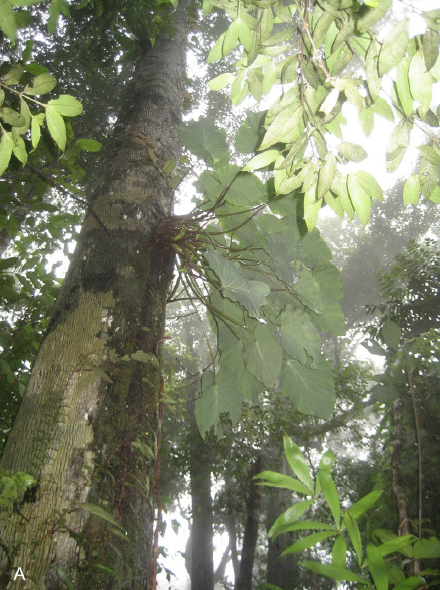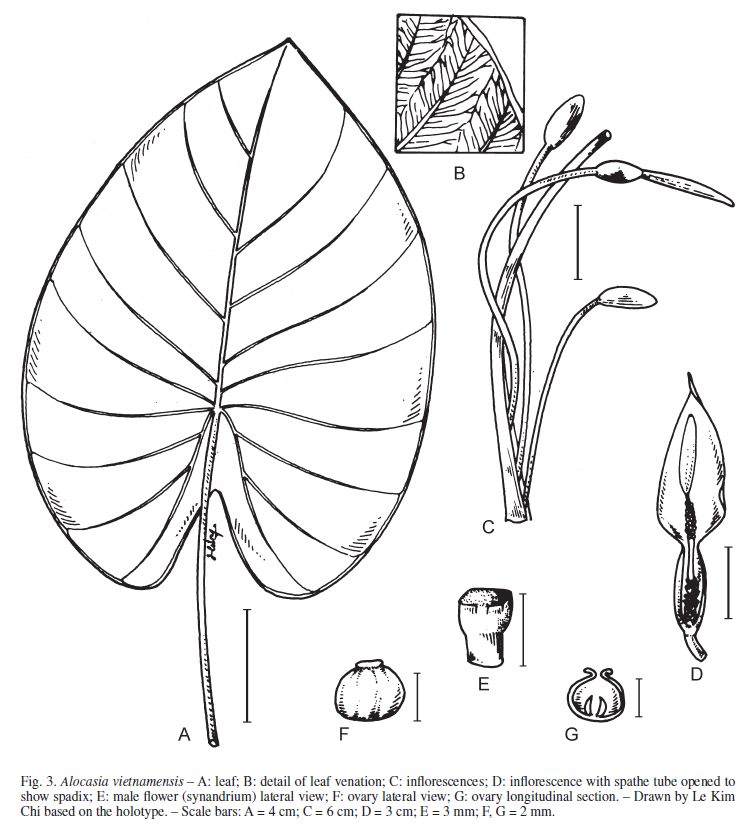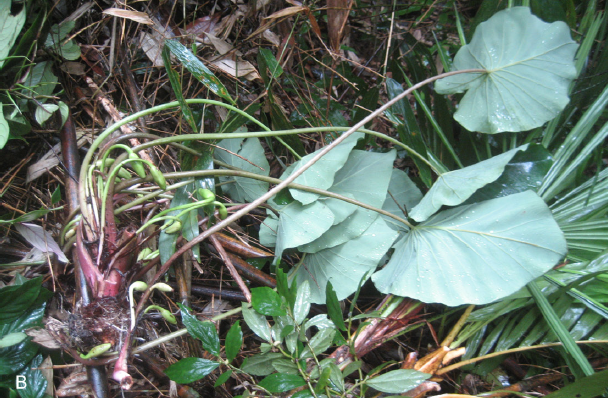ALOCASIA VIETNAMENSIS
ORIGINAL DESCRIPTION:
Alocasia vietnamensis differs from all other species of Alocasia except Alocasia evrardii in having a stipitate spadix with staminodes at the base of the female portion; it differs from Alocasia evrardii in having a rhizomatous stem, peduncles c. ¼ as long as the petioles, and a spathe limb ivory white with a little pale green at the middle outside, white and glossy inside.
SYNONYMS: N/A
DISTRIBUTION: Known only from the type locality in Da Nang province, C Vietnam.
CLIMATE: Tropical humid climate
Humidity is moderate throughout the year, ranging from 60% to 70%
Temperature is varies between the seasons - within the range of 48°F/9°C to 88°F/31°C during the day. Minimum temperatures never dip below 45°F/7°C
Rainy and humid season (October to May) and a dry season between June and October. The average annual rainfall is 1,200 mm
ECOLOGY: Growing as an epiphyte on medium-sized trees in evergreen forests in high wet mountain areas at c. 1560 m above sea level
SPECIES DESCRIPTION:
Herbs evergreen, slightly robust, 70 – 80 cm tall; stem rhizomatous, elongate, 2 – 3 cm in diam., older parts covered by remains of old leaf bases and cataphylls. Leaves up to 5 together; petiole glabrous, red-brown at base, dull green mixed with grey distally, slender, 60 – 80 cm long, sheathing for 15 – 25 cm from base, remains persisting as dark brown fibres when dried; blade bright grey abaxially, dark green adaxially, suborbicular to broadly elliptic, 20 – 33 × 15.5 – 21.5 cm, base shallowly concave, apex obtuse or rounded; basal lobes adnate for 4 – 5 cm, subtriangular to semielliptic, 7.5 – 9 cm long, 7.5 – 10 cm wide at base; veins: lateral veins 4 or 5 pairs, basal veins c. 3 pairs with smaller veins connecting to a middle vein from lateral veins and toward leaf margin.
INFLORESCENCE:
Inflorescences c. 3 together; peduncle erect at first, then bent down at apex at fruiting, dull green to light brown-grey, 15 – 23 cm long, covered at base by dark brown cataphylls when decayed; spathe c. 9 cm long; tube pale green outside, light grey inside, elongate subelliptic, c. 30 mm long, c. 8 mm in diam. at middle; limb almost spreading outward at anthesis with apex still convolute, ivory white with a little pale green at middle outside, white and glossy inside, ovate-oblong, c. 6.5 cm long, c. 2.5 cm wide near base, both surfaces smooth, apex acuminate; spadix stipitate, shorter than spathe, c. 7 cm long; stipe white, c. 5 mm long, c. 2.5 mm in diam.; female portion subcylindric, c. 13 mm long, base narrowed, covered by staminodes; sterile portion corresponding with spathe constriction, white, c. 2.5 cm long, c. 5 mm in diam. at base, c. 2.5 mm in diam. at apex, narrower than fertile portions, covered by staminodes; male portion light yellow, subcylindric, c. 13 mm long, c. 3 mm in diam., base oblong, apex truncate; appendix stipitate, dull white, oblong-conical, c. 2.8 cm long, c. 5 mm in diam. at base, apex acuminate; appendix stipe c. 5 mm long, covered by several rows of white ellipsoid synandrodes. Female flowers: ovaries arranged in 2 or 3 rows, unilocular, green, subglobose, c. 2 mm in diam.; stigma dull yellow, broad, slightly concave, with 2 lobes directed upward on both sides; ovules 4 or 5, basal, straight with very short funicle. Male flowers in groups of 2 or 3, c. 1.2 mm long; stipe 0.6 – 0.7 mm long; thecae conical or cylindrical, c. 0.5 mm long, dehiscing by a pore at apex. Staminodes at base of female portion white, subconical; staminodes of sterile portion long, flattened, parallelogram-shaped.
VARIEGATED FORMS: N/A
ETYMOLOGY: The specific epithet comes from Vietnam, the country of origin for this species.
NOTES:
CULTIVARS: N/A
HYBRIDS: N/A






